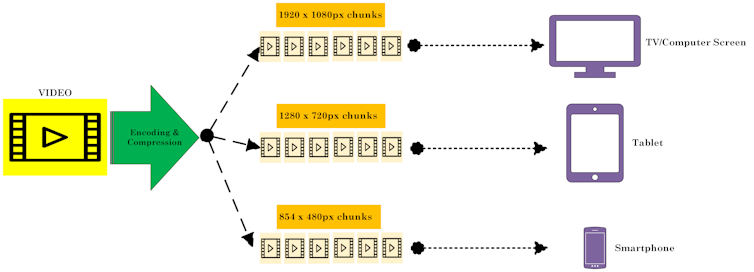## Binge-Watching, Explained: The Science Behind Your Streaming Swoon
Ever wonder how that endless scroll of shows magically appears on your screen, ready to be devoured at your leisure? Behind the seemingly seamless world of streaming lies a symphony of cutting-edge technology, a testament to the rapid evolution of science and communication.

Cloud Computing: The Foundation of Streaming
At the heart of modern streaming technology lies cloud computing, a transformative paradigm shift in how we access and utilize computing resources. Cloud computing involves distributing computing tasks, storage, and data across a network of interconnected servers located in data centers worldwide. This decentralized approach offers numerous advantages for video streaming, particularly in terms of scalability, reliability, and cost-effectiveness.
For video streaming platforms, the cloud provides a flexible and scalable infrastructure to handle fluctuating demand. During peak viewing hours, when millions of users simultaneously access content, cloud resources can be dynamically allocated to ensure smooth playback. Conversely, during periods of low traffic, resources can be reallocated or scaled down, optimizing cost efficiency.
Furthermore, cloud computing enhances the reliability of streaming services. By distributing content across multiple geographically dispersed data centers, the risk of downtime or service disruptions due to hardware failures or localized outages is significantly reduced. If one data center experiences an issue, other data centers can seamlessly take over, ensuring uninterrupted service for users.
Geographic Dispersal: Minimizing Latency
A key challenge in video streaming is latency, the delay experienced between a user’s request for content and its delivery. This delay can be attributed to the physical distance between the user and the data center hosting the video content.
Geographically dispersed data centers play a crucial role in mitigating latency. By strategically positioning data centers closer to user populations, streaming services can significantly reduce the distance data needs to travel. This proximity minimizes the time it takes for video content to reach users, resulting in a smoother and more responsive streaming experience.
Latency is particularly critical for live streaming, where real-time content delivery is essential. Even a slight delay can disrupt the viewing experience and detract from the sense of immediacy. By strategically placing servers closer to users, streaming platforms can ensure that live events are delivered with minimal latency, allowing viewers to feel like they are part of the action.
Addressing Network Congestion
Network congestion can also impede smooth video streaming. When a large number of users attempt to access content simultaneously, the internet infrastructure can become overloaded, leading to buffering, lag, and interruptions.
To combat network congestion, streaming services employ techniques like content caching and traffic shaping. Content caching involves storing copies of popular videos on servers located closer to users, reducing the load on the main data centers and minimizing the need for data to travel long distances. Traffic shaping involves prioritizing video traffic over other types of data, ensuring that streaming flows smoothly even during periods of high network usage.
Content Delivery Networks (CDNs): A Web of Optimization
Content Delivery Networks (CDNs) play a pivotal role in optimizing video streaming by strategically distributing content to edge servers located closer to users worldwide.
Facilitating Faster Content Delivery
Imagine a vast network of interconnected servers strategically positioned around the globe. This network is a CDN, and it acts as a intermediary between the original content source and users. When a user requests a video, the CDN directs the request to the edge server closest to their location. This proximity significantly reduces the distance data needs to travel, resulting in faster content delivery and a more seamless streaming experience.
The Role of Edge Servers
Edge servers are the unsung heroes of CDNs. These servers are located at the “edge” of the network, closer to users than the main content origin servers. They act as caching hubs, storing copies of popular video content. When a user requests a video, the CDN directs the request to the nearest edge server, which delivers the content locally. This reduces the load on the origin servers and minimizes latency for users.
Impact on the Streaming Experience
The benefits of CDNs are readily apparent in the streaming experience. They contribute to faster buffering times, smoother playback, and reduced interruptions. By optimizing content delivery, CDNs ensure that users can enjoy high-quality video streams regardless of their location or internet connection speed.
The Future of Streaming: Innovation and Challenges
Emerging Technologies: Pushing the Boundaries of Streaming
The streaming landscape is constantly evolving, driven by advancements in technology that push the boundaries of what’s possible.
- 5G and High-Speed Networks: The rollout of 5G and other high-speed networks is poised to revolutionize streaming by providing significantly faster download and upload speeds. This will enable even higher-quality video streams, smoother real-time interactions, and the emergence of new immersive experiences like augmented and virtual reality streaming.
- Video Compression and Encoding: Continuous advancements in video compression algorithms are making it possible to deliver high-quality video streams with smaller file sizes. This translates into faster loading times, reduced bandwidth consumption, and more efficient streaming.
- Virtual Reality (VR) and Augmented Reality (AR) Streaming: The rise of VR and AR technologies is creating new opportunities for interactive and immersive streaming experiences. Imagine attending a virtual concert or exploring a museum exhibit from the comfort of your own home.
- Environmental Impact: Data centers consume vast amounts of energy, contributing to greenhouse gas emissions. Streaming services are increasingly investing in renewable energy sources, improving energy efficiency within data centers, and exploring innovative cooling technologies to minimize their environmental footprint.
- Scalability Challenges: Meeting the ever-increasing demand for streaming content requires continuous investment in infrastructure expansion. Streaming platforms are exploring techniques like edge computing, where processing and storage are distributed closer to users, to improve scalability and reduce the strain on centralized data centers.
Sustainability and Scalability: Meeting the Growing Demand
As streaming consumption continues to surge, addressing the environmental impact of data centers and ensuring the scalability of the infrastructure to meet growing demand are paramount concerns.
Conclusion
From the intricate dance of codecs to the vast networks that crisscross the globe, streaming technology has revolutionized how we consume media. We’ve journeyed through the science behind its seamless delivery, exploring the role of bandwidth, buffering, and adaptive bitrates in ensuring a smooth viewing experience. We’ve also glimpsed the power of cloud computing and its impact on content accessibility and personalization.
This evolution of media consumption isn’t just about convenience; it’s a seismic shift in how we interact with information and entertainment. Streaming technology empowers individuals, dismantles geographical barriers, and fuels a globalized cultural exchange. As we move forward, the implications are profound. Imagine a future where personalized learning experiences are tailored to individual needs, delivered instantly and seamlessly. Or envision a world where live events transcend physical limitations, connecting us in real-time across continents. Streaming technology holds the key to unlocking these possibilities, reshaping our world one byte at a time.
The question isn’t simply “how does it work?” but “what will we build with it?” The future of entertainment, education, and connection lies in the hands of those who dare to imagine the boundless potential of streaming technology. Are you ready to shape it?
